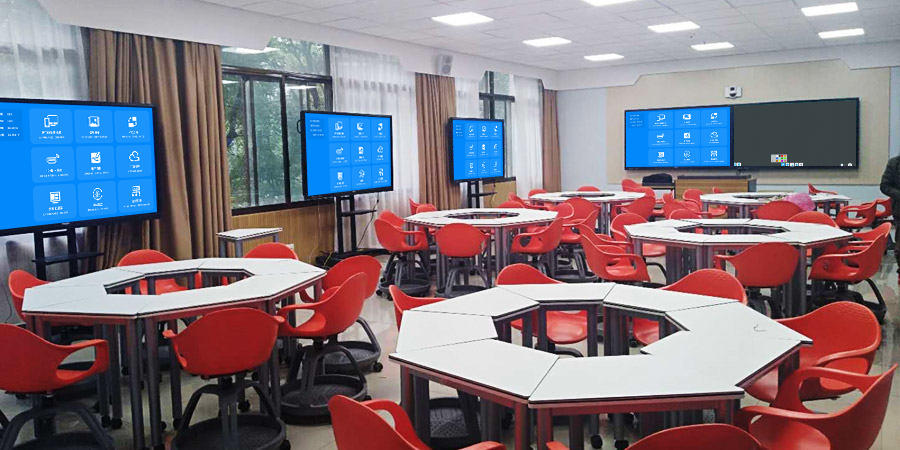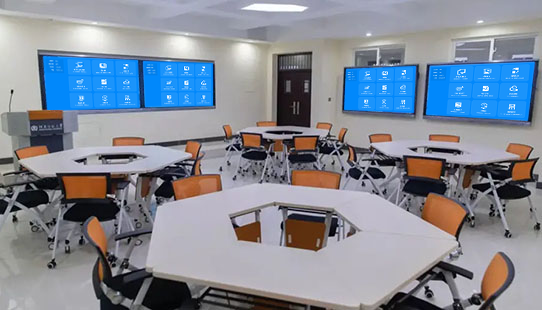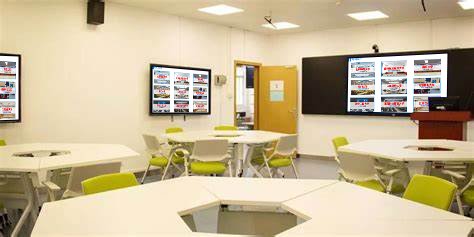Smart Classrooms: An Innovative Solution for Reshaping the Teaching Experience
Amid the wave of digital transformation in education, the smart classroom has evolved from a conceptual idea into a key vehicle for reshaping the teaching experience. Relying on advanced technologies like audio-visual interaction, convenient wireless screen mirroring, and intelligent collaboration management, it breaks the one-way lecture model of traditional classrooms and builds a new educational ecosystem of multi-faceted interaction and efficient collaboration, embarking teachers and students on an immersive, personalized learning journey.
I. Core Needs of Smart Classrooms
The expectations for smart classrooms in the education sector focus on four key dimensions:
- Boosting Classroom Interaction: Moving beyond the traditional “spoon-feeding” approach to introduce interactive formats like group discussions and real-time feedback, encouraging students to shift from passive recipients to active participants in knowledge construction.
- Integrating Teaching Resources and Data: Ensuring the smooth flow of teaching resources between multiple devices and automatically retaining classroom interaction data to provide strong support for precision teaching.
- Simplifying Operations and Management: Striving for simple and easy-to-use device operations, stable and reliable performance, and seamless adaptation to diverse scenarios like regular classes, lab sessions, and remote instruction.
- Ensuring Device Stability and Compatibility: In a classroom environment with multiple concurrent devices and a complex network, the equipment must run stably and be compatible with various brands of computers, tablets, phones, and other terminals.

II. Innovative Technology as the Cornerstone of a Smart Classroom
To meet these core needs, the smart classroom solution integrates a series of cutting-edge technologies:
- Low-Latency, All-Protocol Screen Mirroring: Covering all major protocols, including AirPlay, Miracast, WiDi, DLNA, Google Cast, and the proprietary BJCast protocol, it supports devices running iOS, Android, Windows, macOS, and HarmonyOS. In class, a teacher can mirror a lesson plan from a MacBook, students can submit homework from an Android tablet, and lab equipment can display data via a Windows computer. All can be connected with one click through the core mirroring terminal, with latency as low as 80ms, ensuring smooth visuals and an uninterrupted teaching rhythm.
- Multi-Screen Linkage for Group Teaching: Unlike ordinary mirroring devices, this solution supports the collaborative work of a “main screen + group screens.” The teacher’s main screen can view the content of each group screen in real-time. With a tap of “push to group,” key content can be precisely sent to a specific group, and a group’s discussion results can be presented on the main screen with a single “drag to main screen.” With a built-in interactive whiteboard, the teacher can directly annotate and explain on a student’s mirrored homework, transforming group teaching from a fragmented, independent process into a collaborative, co-creative one.
- Minimalist Operation and Anti-Interference Design: Adhering to the principle of “zero learning cost,” a teacher can easily mirror their screen by scanning a QR code or entering a 6-digit mirroring code with their phone. The device features dual-band Wi-Fi and a smart anti-interference chip. Even in a classroom with 30 people connected simultaneously, it maintains a stable transmission, effectively preventing mirroring interruptions caused by network congestion and perfectly fitting a teacher’s daily habits.
- Integrated Hardware and Software for Data Consolidation: The core mirroring terminal not only handles mirroring tasks but also deeply integrates with the smart classroom management platform. Class content is automatically recorded (supporting RTSP protocol for school recording systems), and student interaction annotations and answer data are synchronized to the platform in real-time. This generates visualized data such as a “classroom interaction heatmap” and “knowledge mastery reports,” helping teachers review teaching effectiveness after class and achieving a full-process data consolidation of the teaching experience.

III. Intelligent Applications in Diverse Scenarios
- Routine Teaching Scenarios: Adopting a BYOD (Bring Your Own Device) teaching model, teachers and students can conveniently mirror content from their phones or computers to the large classroom screen, allowing for flexible display of teaching materials and interactive exchanges. For example, in an English class, a teacher can mirror a clip from an English movie from their phone, and students can complete an online listening test on a tablet and mirror their answers, significantly boosting class participation.
- Group Discussion Scenarios: Using the multi-screen interaction feature, an efficient interaction system is built between the main classroom screen and the group screens. It supports broadcasting from the main screen with one click, broadcasting to specific groups, and displaying a summary of group content. For instance, in a physics lab class, each group can mirror its experimental data and analysis to a group screen, and the teacher can compare and comment on them on the main screen, promoting a collision of ideas and shared experiences among the groups.
- Remote Teaching Scenarios: Leveraging advanced network technology, the system enables the remote synchronized transmission of high-quality teaching resources. Students in remote areas can access the smart classroom system through their devices, watch lectures from renowned teachers in real-time, and interact with the main lecturer and other students. This breaks geographical limitations and promotes the fair development of education.
IV. Tangible Results Demonstrate Value
Many universities and educational institutions have already adopted this smart classroom solution, with remarkable results:
- National University of Defense Technology: Over 120 traditional classrooms were modernized, including hardware upgrades, deployment of existing teaching software platforms, custom software development and optimization, hardware and software compatibility debugging, and basic environment construction. The renovated tiered multimedia classrooms, flat smart classrooms, multi-window interactive classrooms, and discussion-oriented classrooms provide a more efficient teaching environment for teachers and students.
- Beijing Normal University: With the construction of 130 smart classrooms, the solution’s interactive features and data consolidation mechanism enable teachers to accurately grasp students’ learning status and adjust teaching strategies, leading to a significant improvement in teaching quality.
- Nanjing University of Aeronautics and Astronautics: The smart mirroring solution was deployed in over 600 classrooms, enabling the quick sharing of teaching resources and interaction. This has stimulated students’ learning enthusiasm and made the classroom atmosphere more active.
The smart classroom solution remains committed to the original goal of “serving the essence of teaching,” using technology to empower education and making it a powerful assistant for educational progress, not a burden. Choosing this solution means achieving a smooth transition and comprehensive upgrade from a traditional to a smart classroom at a lower cost and higher efficiency, injecting continuous momentum into the innovative development of education.
